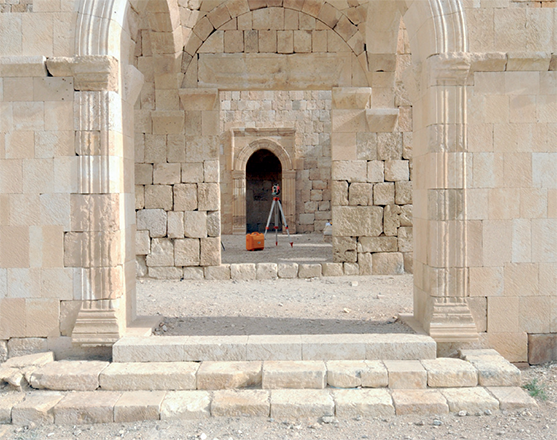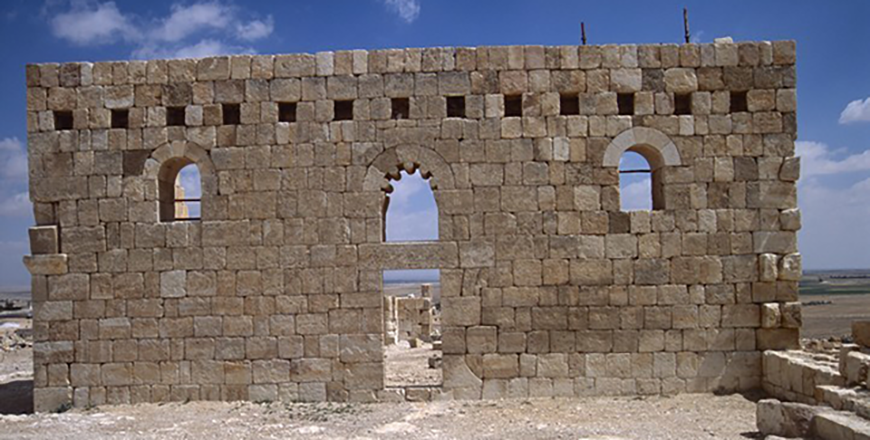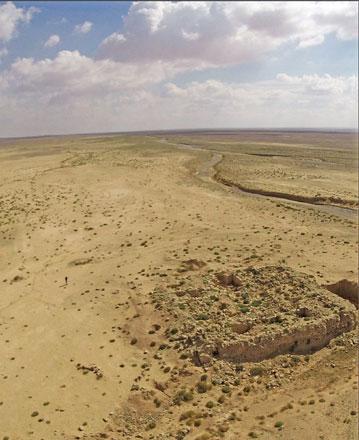You are here
Ancient strategic importance of north-eastern Badia revealed by Roman, Byzantine, early Islamic desert castles
By Saeb Rawashdeh - Dec 01,2023 - Last updated at Dec 01,2023

Qasr Hallabat was a complex of buildings located in the eastern desert which originally was a Roman fortification constructed in 2nd-3rd centuries AD to protect the eastern frontier (Photo courtesy of Ignacio Arce)
AMMAN — The north-eastern Badia in Jordan was a strategic area among great powers in ancient times. The Roman and Byzantine empires established defensive lines of towns and fortification towards Parthian and Sassanid empires.
In Early Islamic times these settlements were mainly characterised by the emergence of various impressive monuments, known as “desert castles” or qusur and their role was residential.
Desert castles form a group of monuments that covers the entire region of Bilad Al Sham and includes different types of buildings and settlements.
“In addition to representative buildings, various hydraulic installations form defining structural units in many sites and suggest an at least temporary agricultural use of the semi-arid steppe,” noted Karin Bartl from the German Archaeological Institute in Berlin, adding that another group consists of larger villages with scattered buildings, which apparently arise at the same time.
These settlements were isolated and did not number a big number of towns in the period from 7th century AD to 9th century. However, it can be assumed that in addition to the partially long-known structures, further isolated farmsteads and small settlements existed, which can only be recognised by intensive prospecting and will hopefully complement the current settlement image in the future Bartl outlined.
“The term ‘Early Islamic’ describes the first two periods after the Islamic conquest: the Umayyad caliphate [661-750] and the first phase of the Abbasid dynasty [750-1257]. The centre during the Umayyad rule was Damascus; after the seizure of power by the Abbasids in 750, the centre of the empire moved first to Al Anbar on the Euphrates and later to Baghdad, where under the second caliph Al Mansur the Abbasid capital was established from 762 onwards,” Bartl elaborated.
The region has been often affected by different political turmoil and from the end of the 9th century; the south-western part of the empire was under the control of the Tulunids (878-905) and Ikhshidids (935-969), who were replaced by the Fatimids in 969.
“With the Umayyad conquest, a new division into military provinces, the ajnad (singular jund) took place. The region to the north, east and south-east of Damascus as far as Ayla/Aqaba now formed the jund Dimashq, which encompassed the entire area of central Syria and eastern Jordan including large parts of the Badia,” Bartl said, noting that the western border areas of the coastal zone between Sidon/Saida and Gaza to the Jordan Valley as well as the Golan formed the ajnad Al’Urdunn in the north and Filastīn in the south.
Furthermore, the provinces were divided into different districts, among which the units of jund Dimashq, Balqa, Bathaniyya and Hauran, with the capitals Damascus/Dimashq, ‘Amman, Dar’a and Busra, bordered immediately west and north of the north-eastern), she explained, adding that the Umayyad reign (661-750) is characterised in all parts of the empire by dynamic construction activity.
“In the north-eastern Badia, this period represents the last settlement phase characterised by significant building activities with numerous new foundations before the beginning of the re-settlement of the region, which has been observed for some twenty years. Contrary to this development, up to now very few building activities are documented for the early Abbasid period,” Bartl underlined
The east and to the southeast, in Roman and late Roman times, was characterised by watch posts, which were built within the framework of border control and frequent conflicts with first Parthian state and later on Sassanid Empire.
“On the basis of older interpretations and new field research, the Early Islamic sites have recently been linked to three primary functions, which, however, are not all necessarily relevant at the same time in the various sites: as a meeting place for caliphal elites and local tribal leaders, as agricultural estates to increase state revenues, and as a permanent or temporary residence for elites,” Bartl highlighted.
These castles had a function of caravan way stations, hunting lodges, private quarters and places for informal gatherings.
“In view of the numerous gaps between the surveyed areas of the north-eastern Badia, no definite statement on settlement development over large areas is currently possible. However, recent surveys focused explicitly on the documentation of Late Antique and Early Islamic sites, have shown that the density of sites was rather low for the Early Islamic period,” Bartl underscored.
Related Articles
AMMAN — The ancient city of Gadara (modern Umm Qais) was developed during the Hellenistic and Roman eras and was part of the Decapolis
AMMAN — The Umayyad period represents a very dynamic phase in the history of the Levant in terms of the political transition, architecture a
AMMAN — Qasr Mushash, located 40 kilometres east of Amman, was probably used for postal services during the Umayyad period, according to a G

















